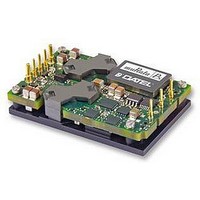UQQ-5/20-Q48P-C Murata Power Solutions Inc, UQQ-5/20-Q48P-C Datasheet - Page 9

UQQ-5/20-Q48P-C
Manufacturer Part Number
UQQ-5/20-Q48P-C
Description
CONVERTER, DC/DC, WI, 100W, 5V
Manufacturer
Murata Power Solutions Inc
Series
UQQr
Datasheet
1.UQQ-3.325-Q12P-C.pdf
(14 pages)
Specifications of UQQ-5/20-Q48P-C
Output Type
Single
No. Of Output Channels
1
Input Voltage
18V To 75V
Power Rating
100W
Output Voltage
5V
Output Current
20A
Supply Voltage
48V
Dc / Dc Converter Case Style
Quarter Brick
Dc / Dc Converter O/p Type
Single
No. Of Outputs
1
Approval Bodies
EN / IEC / UL
Rohs Compliant
Yes
Product
Isolated
Output Power
100 W
Input Voltage Range
18 V to 75 V
Input Voltage (nominal)
48 V
Number Of Outputs
1
Output Voltage (channel 1)
5 V
Output Current (channel 1)
20 A
Isolation Voltage
2.25 KV
Package / Case Size
Quarter Brick
Lead Free Status / RoHS Status
Lead free / RoHS Compliant
UQQ Series Aluminum Heatsink
Please note – The UQQ series shares the same heatsink kits as the UVQ
series. Therefore, when ordering these heat sinks, use the model numbers
below which end with the ‘UVQ’ suffix. The UQQ series converter baseplate
can be attached either to an enclosure wall or a heatsink to remove heat from
internal power dissipation. The discussion below concerns only the heatsink
alternative. The UQQ’s are available with a low-profile extruded aluminum
heatsink kit, models HS-QB25-UVQ, HS-QB50-UVQ, and HS-QB00-UVQ.
This kit includes the heatsink, thermal mounting pad, screws and mounting
hardware. See the assembly diagram below. Do not overtighten the screws in
the tapped holes in the converter. This kit adds excellent thermal performance
without sacrificing too much component height. See the Mechanical Outline
Drawings for assembled dimensions. If the thermal pad is firmly attached, no
thermal compound (“thermal grease”) is required.
When assembling these kits onto the converter, include ALL kit hardware to
assure adequate mechanical capture and proper clearances. Thread relief is
0.090" (2.3mm).
www.cd4power.com
P O W E R E L E C T R O N I C S D I V I S I O N
Figure 7. Model UQQ Heatsink Assembly Diagram
Thermal Performance
The HS-QB25-UVQ heatsink has a thermal resistance of 2 degrees Celsius
per Watt of internal heat dissipation with “natural convection” airflow (no
fans or other mechanical airflow) at sea level altitude. This thermal resistance
assumes that the heatsink is firmly attached using the supplied thermal pad
and that there is no nearby wall or enclosure surface to inhibit the airflow. The
thermal pad adds a negligible series resistance of approximately 0.5°C/Watt
so that the total assembled resistance is 2.5°C/Watt.
Be aware that we need to handle only the internal heat dissipation, not the full
power output of the converter. This internal heat dissipation is related to the
efficiency as follows:
Efficiency of course varies with input voltage and the total output power.
Please refer to the Performance Curves.
Since many applications do include fans, here is an approximate equation to
calculate the net thermal resistance:
Where,
RQ [at airflow] is the net thermal resistance (in °C/W) with the amount of
airflow available and,
RQ [natural convection] is the still air total path thermal resistance or in this
case 2.5°C/Watt and,
“Airflow in LFM” is the net air movement flow rate immediately at the converter.
This equation simplifies an otherwise complex aerodynamic model but is
a useful starting point. The “Airflow Constant” is dependent on the fan and
enclosure geometry. For example, if 200 LFM of airflow reduces the effective
natural convection thermal resistance by one half, the airflow constant would
be 0.005. There is no practical way to publish a “one size fits all” airflow
constant because of variations in airflow direction, heatsink orientation,
adjacent walls, enclosure geometry, etc. Each application must be determined
empirically and the equation is primarily a way to help understand the cooling
arithmetic.
This equation basically says that small amounts of forced airflow are quite
effective removing the heat. But very high airflows give diminishing returns.
Conversely, no forced airflow causes considerable heat buildup. At zero
airflow, cooling occurs only because of natural convection over the heatsink.
Natural convection is often well below 50 LFM, not much of a breeze.
While these equations are useful as a conceptual aid, most users find it very
difficult to measure actual airflow rates at the converter. Even if you know
the velocity specifications of the fan, this does not usually relate directly to
the enclosure geometry. Be sure to use a considerable safety margin doing
thermal analysis. If in doubt, measure the actual heat sink temperature with
a calibrated thermocouple, RTD or thermistor. Safe operation should keep the
heat sink below 00°C.
Power Dissipation [Pd] = Power In – Power Out [1]
Power Out / Power In = Efficiency [in %] / 100 [2]
Power Dissipation [Pd] = Power In x (1 –Efficiency%/100) [3]
Power Dissipation [Pd] = Power Out x (1 / (Efficiency%/100) - 1) [4]
RQ [at airflow] = RQ [natural convection] / (1 + (Airflow in LFM) x
[Airflow Constant]) [5]
Wide Input Range Single Output DC/DC Converters
D C / D C C O N V E R T E R S
UQQ Series
MDC_UQQ_A02
Page 9 of 4



















